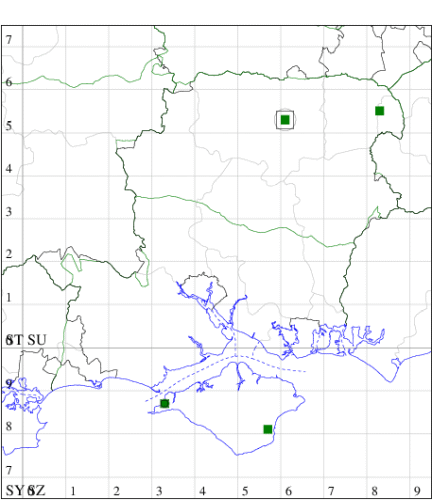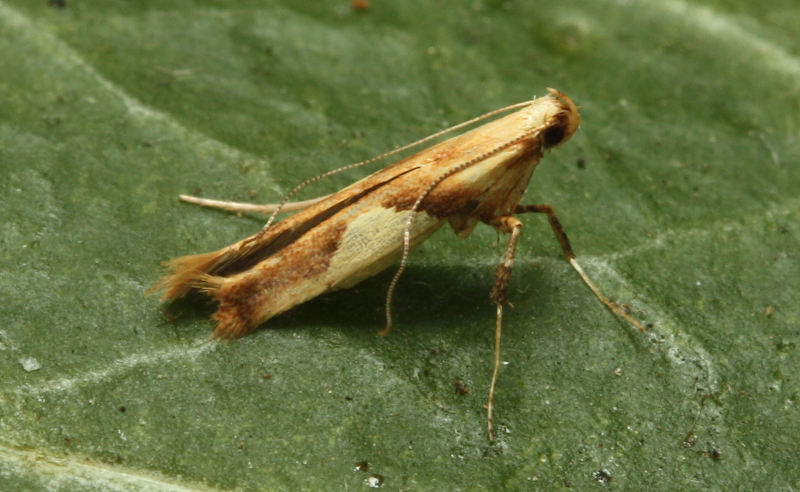Caloptilia honoratella
Checklist Number15.0131 [B&F: N/A]
Verification
Record will require further evidence, at least a good photograph, unless CMR is aware recorder has confidence in identification
Classification
| Family: | Gracillariidae |
| Subfamily: | Gracillariinae |
| Genus: | Caloptilia |
| Species: | honoratella |
| Authority: | (Rebel, 1914) |
First recorded in Surrey in 2017, with another in Kent, April 2019. The third in Suffolk during September 2019 was followed by more in 2020 and it is thought likely that it is now resident in this county and likely elsewhere, after spreading rapidly westwards across Europe in recent years. The first for our area was taken at light in the Isle of Wight in 2021. It was new for Hampshire (VC12) in 2022. The moth is single brooded, occurring from August to May and hibernating as an adult.
Very similar in some forms to C. hemidactylella, and potential specimens should be retained initially for photography but will need dissection for confirmation. General coloration is a deep cream colour with brown ‘inverted V’ and other markings. The larvae feed on maples, mainly Sycamore Acer pseudoplanatus in our country, creating a typical Caloptilia blotch mine between two veins before moving to feed in a rolled cone at a leaf-lobe.
Very similar in some forms to C. hemidactylella, and potential specimens should be retained initially for photography but will need dissection for confirmation. General coloration is a deep cream colour with brown ‘inverted V’ and other markings. The larvae feed on maples, mainly Sycamore Acer pseudoplanatus in our country, creating a typical Caloptilia blotch mine between two veins before moving to feed in a rolled cone at a leaf-lobe.


The abundance in each month is indicated as follows:
 No records
No records Very occasional
Very occasional Irregular
Irregular Uncommon
Uncommon Off-peak, but not unusual
Off-peak, but not unusual Off-peak, but not unusual
Off-peak, but not unusual Main flight time
Main flight time| J | F | M | A | M | J | J | A | S | O | N | D | |
|---|---|---|---|---|---|---|---|---|---|---|---|---|
| Adult |  |  |  |  |  |  |  |  |  |  |  |  |
| Larval |  |  |  |  |  |  |  |  |  |  |  |  |
Records by week (adult)
Records by week (larval)
VC10 Isle of Wight
| Site | Date | Quantity | Recorder | Stage |
|---|---|---|---|---|
| Totland (SZ38) | 24/07/2021 | one | Rachel Terry | Adult |
| Totland (SZ38) | 01/10/2021 | one | Rachel Terry | Adult |
| Shanklin (SZ58) | 28/03/2022 | one | Iain Outlaw | Adult |
| Whitwell Road, Ventnor (SZ57) | 02/10/2023 | one | Mark G Telfer | Adult |
| Whitwell Road, Ventnor (SZ57) | 05/11/2024 | one | Mark G Telfer | Adult |
| Ventnor (SZ57) | 05/11/2024 | one | Mark G Telfer | Adult |
VC11 South Hampshire
| Site | Date | Quantity | Recorder | Stage |
|---|---|---|---|---|
| Waterlooville (SU60) | 24/08/2024 | one | David Wheatley | Adult |
VC12 North Hampshire
| Site | Date | Quantity | Recorder | Stage |
|---|---|---|---|---|
| Basingstoke (SU65) | 12/07/2022 | one | Mike Wall | Adult |
| Basingstoke (SU65) | 19/07/2022 | one | Mike Wall | Adult |
| Basingstoke (SU65) | 13/08/2022 | two | Mike Wall | Adult |
| Fleet Pond (SU85) | 20/08/2022 | one | Mike Halsey | Adult |
| Blackwater (SU85) | 09/08/2023 | one | Ben Dale | Adult |
| Windmill Hill, Chalton (SU73) | 05/09/2023 | one | Chris Piper | Adult |
| Basingstoke (SU65) | 18/07/2024 | one | Mike Wall | Adult |
| Hammer Vale, Woolmer (SU83) | 22/07/2024 | one | Andy Swan | Adult |
| Hammer Vale, Woolmer (SU83) | 30/07/2024 | one | Andy Swan | Adult |
| Magdalen Hill Down NR (SU42) | 18/08/2024 | - | Jack Oughton | Mine |
| Basingstoke (SU65) | Jun-25 | one | Mike Wall | Adult |







